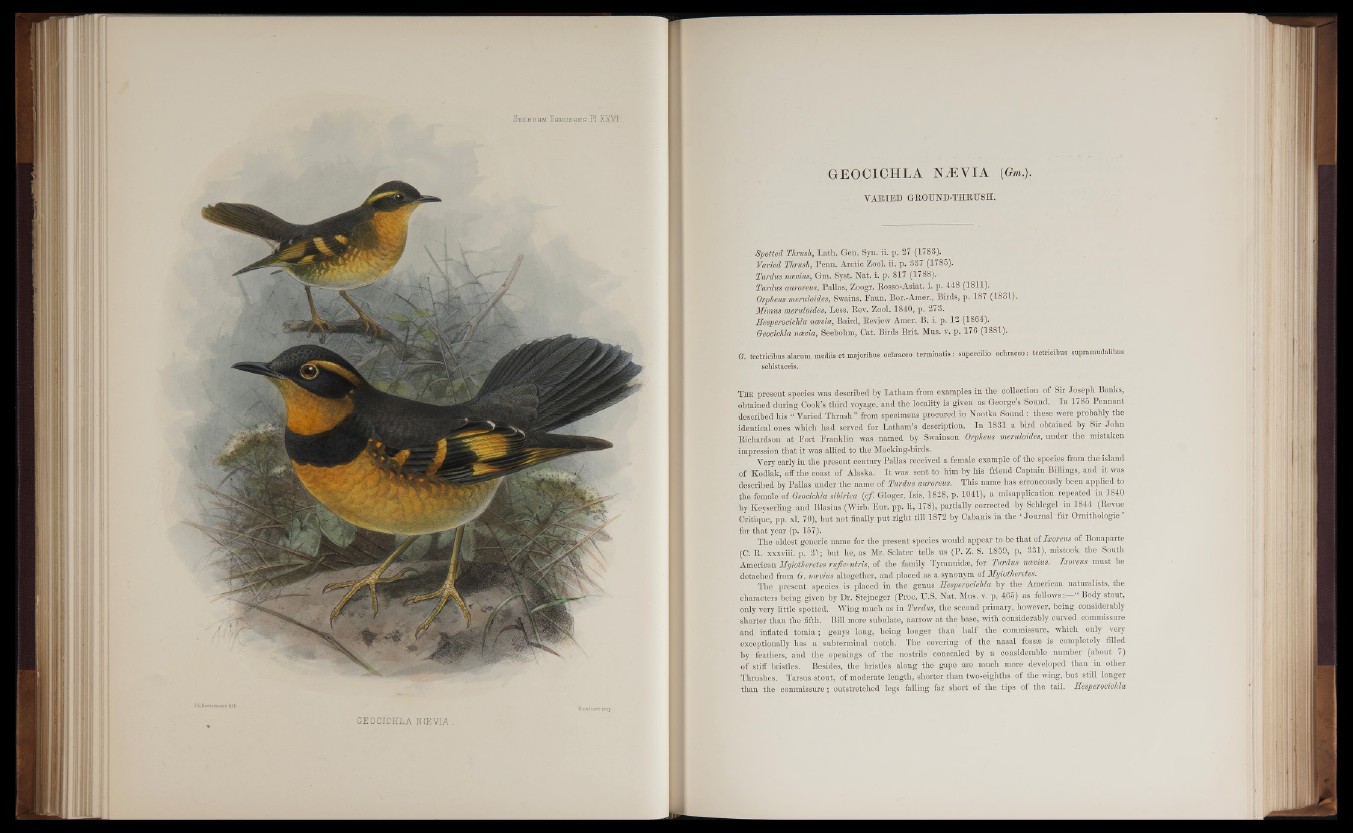
VARIED GROUND-THRUSH.
Spotted Thrush, Lath. Gen. Syn. ii. p. 27 (1783).
Varied Thrush, Penn. Arctic Zool. ii. p. 337 (1785).
Turdus neevius, Gm. Syst. Nat. i. p. 817 (1788).-
Turdus auroreus, Pallas, Zoogr. Bosso-Asiat. i. p. 448 (1811).
Orpheus meruloides, Swains. Faun. Bor.-Amer., Birds, p. 187 (1831).
Mimus meruloides, Less. Bev. Zool. 1840, p. 273.
Eesperocichla ncevia, Baird, Beview Amer. B. i. p. 12 (1864).
Geocichla ncevia, Seebohm, Cat. Birds Brit. Mus. y. p. 176 (1881).
G. tectricibus alarum, mediis et majoribus ochraceo terminatis: supercilio ochraceo: tectricibus supracaudalibus
scbistaceis.
T he present species was described by Latham from examples in the collection of Sir Joseph Banks,
obtained during Cook’s third voyage, and the locality is given ■ as George’s Sound. In 1785 Pennant
described his “ Varied Thrush ” torn specimens procured in Nootka Sound : these were probably the
.identical ones which had served for Latham’s description. In 1831 a bird obtained by Sir John
Richardson at.Port Franklin was named by Swainson Orpheus meruloides, under the mistaken
impression that it was allied to the Mocking-birds.
Very early in the present century Pallas received a female example of the species from the island
of Kodiak, off the coast of Alaska. It was sent to him by his friend Captain Billings, and it was
described by Pallas under the name of Turdus auroreus. This name has erroneously been applied to
the female of Geocichla silinca {of. Gloger, Isis, 1828, p. 1011), a misapplication repeated in 1840
by Kevserling and Blasius (Wirb. Eur. pp. Ii, 178), partially corrected by Schlegel in 1844 (Revue
Critique, pp. xl, 70), but not finally put right till 1872 by Cabanis in the ‘ Journal fur Ornithologie ’
for that year (p. 157).
The oldest generic name for the present species would appear to.be that oilxoreus of Bonaparte
(C. B. xxxviii. p. 3); but he, as Mr. Sclater tells us (P. Z. S. 1859, p. 331), mistook the South
American Myiotheretes rufivcntris, of the family Tyrannidae, for Turdus neevius. Ixoreus must be
detached from G. neevius altogether, and placed as a synonym of Myiotheretes.
The present species is placed in the genus Eesperocichla by the American naturalists, the
characters being given by Dr. Stejneger (Proc. U.S. Nat. Mus. v. p.. 465) as follows:—“ Body stout,
only very little spotted. Wing much as in Turdus, the second primary, however, being considerably
shorter than the fifth. Bill more subulate, narrow at the base, with considerably curved commissure
and inflated tomia; genys long, being longer than half the commissure, which only very
exceptionally has a subterminal notch. The covering of the nasal fossae is completely filled
by feathers, and the openings of the nostrils concealed by a considerable number (about 7)
of stiff bristles. Besides, the bristles along the gape are much more developed than in other
Thrushes. Tarsus stout, of moderate length, shorter than two-eighths of the wing, but still longer
than the commissure; outstretched legs falling far short of the tips of the tail. Eesperocichla